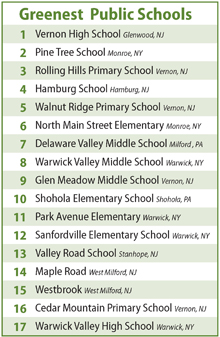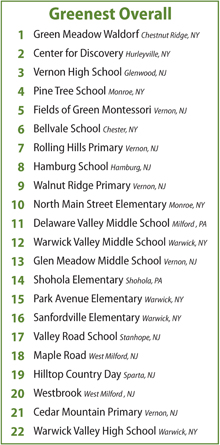Green schools 2016
| 29 Jun 2016 | 01:00

Justin M., 18, a student at The Center for Discovery, with a laying hen. Photo by Jesse Wall

A first-grader at Walnut Ridge Elementary School is psyched to be on Green Team duty today. Photo by Becca Tucker

An aide went out and had these made on her own dime. They make a big difference, but some days they wish they had hazmat suits, particularly when yogurt or ketchup are involved. Photo by Becca Tucker

BT: An aide, a janitor and a first-grader work side by side, helping students sort compost from recyclables from trash at the end of a lunch period. Photo by Becca Tucker

Many students here have "extreme behaviors – but they don’t break many eggs," said Tom Burnham, the assistant chief of education at The Center for Discovery. "The door, the wall? That's a different story." Photo by Jesse Wall

"Access to nature, food and nutrition, and physical movement are not add-ons. They're foundational." - Helena le Roux Ohm, director of training, The Center for Discovery. Photo by Jesse Wall


The farm has grown to include sheep, pigs and cows and chickens. "We're not just fussy hippies eating tofu," said CEO Patrick Dollard. "I might be, but..." Photo by Jesse Wall

78% of respondents said the school had reduced facility-related greenhouse gas emissions/energy consumption over the past five years
70% use alternative water sources for irrigation (i.e. gray water, rainwater)
75% said more than half of students' physical education takes place outdoors
81% reported improvements to the HVAC system over the past five years
60% of cafeterias serve local, fresh food
65% have a school garden
But there's plenty of room for improvement.
44% of respondents said part of their school meets green building standards
67% said none the school's energy was renewable
22% said some of the food purchased by the school is environmentally preferable, i.e. organic

Profile: The healing power of hard work
At a visionary residential center, farming is therapy
As a seven-year-old, Patrick Dollard got to drive the horse team on his grandfather's Sullivan County dairy farm, while his older brothers pitched hay.
“I'm driving 4,000 pounds of power. You're dying of hay fever in the fields,” he recalled. “I grew up with a romantic notion of farming.”
Today, in a way, Dollard is still running a farm in Sullivan County. He is president and CEO of The Center for Discovery, a remarkable facility based in Hurleyville, NY that has quietly evolved not only into the largest residential treatment center for disabled children in the state, but also a visionary, industrial-capacity farm that grows clean food for its students and staff, plus a 300-member CSA and a farm market on Hurleyville's Main Street.
This “is a place of miraculous care and innovation,” said one father, whose son lives at The Center.
“It's like a resort,” said the mother of a nonverbal 16-year-old with autism. “He came home the other day with his black sandals turned burgundy from planting in the garden dirt.”
Born out of the ashes of the institutions where we once warehoused our disabled, this campus could not feel more different. It does look like somewhere you'd want to vacation, but the students here — whose complex diagnoses often include autism and mood disorders — do real work.
The sweaty Wednesday Dirt visited, two young men were tending to a flock of 300 chickens alongside their teacher and one of the farmers. Each Thursday, they move the chicken wagons (built from wood milled on-site) to fresh pasture. In preparation, today's chores included cleaning the wagons and laying fencing in the new location. Then there are the everyday tasks: putting fresh straw in the laying boxes, feeding and watering the hens, collecting eggs. The farm produces 250 dozen eggs a week, and learning is embedded in every step, from egg collection to washing to sorting to packaging.
“Nasty breed!” a student says over and over. He pecks his teacher with two fingers, then pecks me, in imitation of what the Rhode Island Reds do when he reaches under them for eggs.
“We don't peck people we don't know,” his teacher tells him, gently but firmly.
The focus for this 18-to-21-year-old cohort is on vocational training: performing multi-step tasks, putting stuff back when done, wearing appropriate gear (like gloves and hair nets when making herbs into balms, which can be off-putting for people with sensory issues), and crucially, on social interactions.
A farm turns out to be the ideal classroom. That's not necessarily because these students are all cut out to be farmers, but because the “caring model” is achieving breakthroughs, said Dollard, with kids who once seemed unreachable.
“A lot of people thought chickens would never work,” said Dollard. Why? “They thought they'd break the eggs, eat the chickens,” he deadpanned.
The opposite has happened. “We've had kids who are dangerous” — who smash doors, windows, walls — “who have started to work with chickens and eggs, and they are very careful,” he said. “It could not have happened any other way.”
The physical activity releases calming endorphins, and, along with a healthy diet, shaves weight off the subtantial number who come to The Center obese. The routine provides a framework that allows a dysregulated brain to settle down and get comfortable. Autistic children who can't make eye contact with people can, for whatever reason, make “total eye contact with animals,” said Dollard. “They can go right inside a cow's face.”
Having a hand in producing the food also helps with buy-in when it comes time to eat it, which is not always so easy. Lots of the students have challenging behaviors around mealtime; many come to The Center having subsisted on processed food. The cookbook that The Center put out last year describes the “French Fry Method” of coaxing picky eaters along. The kitchen staff starts with organic potatoes, frying and freezing, then frying them again like they do at fast food restaurants. Then they cut the fries thicker, than bake them, then switch to sweet potatoes, and finally, whip up a fermented ketchup that contains gut-healthy probiotics.
Nourishment is the foundation upon which everything else here rests. The farm's raison d'etre “came from food security. We wanted to be sure we knew what was in the food. We were concerned about antibiotics, pesticides, all the sh** we put in food,” said Dollard.
“We had a thought about food as medicine decades before Whole Foods, the organic movement.”
Dollard himself is mostly vegetarian, but “we're not just fussy hippies eating tofu,” he said. “Well, I might be,” he conceded, but “I think the staff connected to the agricultural program the day we started eating bacon.”
The farm has been certified organic for decades, and is now also certified biodynamic — a much more stringent standard that involves, for example, growing most of your animals' feed. There may be only one other biodynamic farm in the state. Pastures included, the farm now spans about 500 acres, and is nearing the break-even point where it will pay for itself. For the first 15 or so years, it had cost about $500,000 a year to run.
“This is a legitimate farming operation,” said Dollard. “It's not a petting zoo.”
Profile: A big hot mess
Kindergartners learn to compost
In the beginning, the kids got so excited that they were throwing their entire lunches into the five-gallon buckets. “They almost didn't want to eat,” said Principal Rosemary Gephardt.
Since then, the kindergartners and first graders at Walnut Ridge Primary School in Vernon, NJ have gotten used to composting their food scraps. But there are still occasional tears when someone is not chosen to be on the Green Team. The school aides wish they had hazmat suits some days, but among the kids it's considered a distinction to don the emblazoned apron and help your peers sort their scraps from trash from recycling.
“Before, it was dump dump dump,” said Gephardt. “The kids are very finicky. They're very young. They don't finish everything. We were throwing away so much.”
The gym teacher, Todd Piontkowski, offered to take the scraps home in his truck, to feed his 12 laying hens. “I talked to Rosemary about it last year,” he said, standing in the cafeteria drinking a mini carton of milk. “She kind of looked at me a little sideways.”
But Gephardt came around pretty quickly (partly, she hinted, to move up in these rankings). She doubled down on plastic gloves and re-worked the system of stations where the kids are called up, table by table, to dissect the remains of their lunches. Now everything has its place: grains in one bucket, fruits and veggies in another. Even a half-drunk milk gets poured into a pail so that the carton can be recycled.
The librarian, Ben Joseph, made a video with the students to demo the sorting process. “Sorting is a skill to be learned. They're using visual cues to be independent,” he said.
Still, holding a tray with one hand while you separate a sandwich with the other is dicey at any age. “It's a big hot mess,” said Gephardt. But worth it. The school has cut its cafeteria garbage down from six bags a day to about one. One! Meanwhile, they generate much more recycling, and eight to 13 pounds of scraps every day.
Everyone's into it. Joseph, the librarian, has started a partnership with TerraCycle, collecting and sending them hard-to-recycle things that kids generate lots of, like Capri Sun and Honest Kids pouches. An aide went out and got Green Team aprons made on her own dime. And near the end of the school year, Elizabeth Barthold, the mom of a preschooler, started taking the scraps home to her dad's 16-acre farm.
Her dad, Dennis Iulo, is a lawyer when he's not tending to Earth Man Farm. “The Italians, they always farm until they die,” said Barthold. “They love the dirt.” Iulo has been burying the scraps in his pumpkin field.
Does it get messy? But of course.
“Today, they had the mac and cheese. I had to use my fingers, but it's all right,” said Barthold. “I had napkins in the car, I washed my hands. I don't get grossed out by it.”
Profiles by Becca Tucker
Survey compiled by Susan Wynn
Do you know of another green school? Tell us about it: editor.dirt@strausnew.com